|
9/19 - Wednesday – French River, Prince Edward Island (PEI) to Charlottetown (PEI)
We had breakfast in The Beach House Inn’s cheery, bright sunroom, but the food didn’t live up to our expectations of such a place -- ho hum bacon and stomach turning French toast drizzled with chocolate. The sugar high from breakfast was enough to get us hopping on down the road.
This was our day to do “Lucy Maud Montgomery” – famous author of Anne of Green Gables. Prince Edward Island is where she grew up. The land, the sea and the people around her inspired her wonderful writing. 400,000 people come every year to PEI just to see Green Gables. We visited so many places where she hung out. Amazing woman – here’s a little bio:
Lucy Maud Montgomery
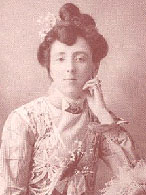
- November 30, 1874 - April 24, 1942
- Long Scottish heritage – many family members are still prominent in PEI
- Born at home in Clifton on the north shore of Prince Edward Island
- Maud's mother, Clara Woolner MacNeil, died at age 23 when Maud was 21 months old.
- Went to live at maternal grandparents’ house in nearby Cavendish. They ran the Post Office from their house.
- Grandma McNeil had literary talent
- Maud's father, Hugh John Montgomery, married Maud's step-mother, Mary Anne McCrae in 1887. Lucy Maud didn’t get along with her stepmother, so she didn’t spend much time with her father.
- Went away to college and became a teacher
- Grandfather became sick so returned to take care of her aging grandma. Stayed with her grandmother for 13 years.
- Wrote constantly – submitted manuscripts of Anne of Green Gables to publishers, but didn’t tell anyone. She got four rejections and put them in a hatbox. Years later, she sent the manuscript to a fifth publisher – and found instant success.
- The local minister, Rev. Ewen Macdonald, fell in love with her and waited 13 years to marry her (while she was caring for her grandmother).
- They finally married on July 11, 1911 in Prince Edward Island – She was 36; he was 39.
- They moved to Ontario after the wedding because he was assigned to a new church.
- They had three sons in Ontario. One died in infancy.
- Lucy Maud was always homesick for her beloved Prince Edward Island.
- She died in Toronto April 24, 1942 and was buried at Cavendish, Prince Edward Island.
- She wrote dozens of books and poetry. Her most famous, Anne of Green Gables has been translated into 15 languages and made into a film. Her sons have published her personal journals in five volumes and have done very well.
|
Our first stop was at the birthplace of Lucy Maud. It was a lovely home furnished like it was in the 1870’s. Our guide was a lovely local lady who adored Lucy Maud and re-reads her books every winter. The home is privately owned by 5 local ladies. You can just feel the love they pour into that place. On display were wonderful photographs, her childhood scrapbooks and her wedding dress. The scrapbooks were filled with things that interested Lucy Maud. On one page, Lucy Maud pasted a lock of her cat’s fur along with pictures of cats she cut from magazines. She loved cats. We bought Zi a kid’s book version of Anne of Green Gables.
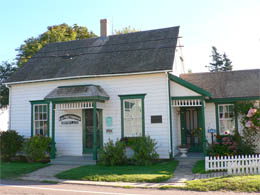
Birthplace of Lucy Maud Montgomery |
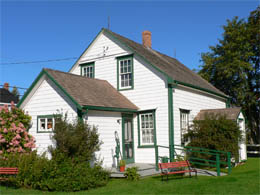
Back of the house |
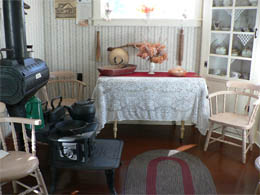
The kitchen |
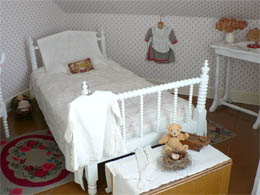
The bedroom |
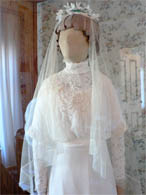
Lucy Maud’s wedding dress |
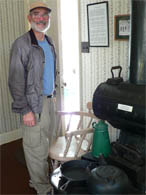 Bill In Lucy Maud’s house |
We drove to the L. M. Montgomery’s Cavendish National Historic Site to see Green Gables (the home that inspired Anne of Green Gables) and to visit the site where her grandparent’s house once stood.
It was a bright sunny day and the house and grounds were perfect. The place was set up as a farmhouse in the late 1800’s. After the orientation film, we visited the museum, the barn and then the house. I enjoyed all the wonderful pictures of Lucy Maud growing up – her class pictures from the one-room schoolhouse days, pictures of her with her Jersey cow and her sheep. The barn was a magnificent museum in its own right. What wonderful displays – like having a peak at the family photo album.
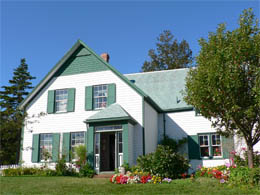
Green Gables house |
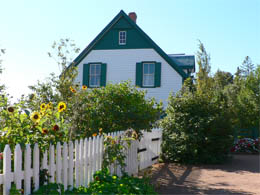
Picket fence - Green Gables house |
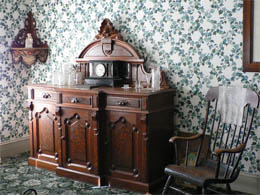
House interior |
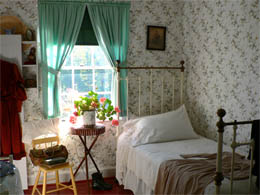
Upstairs bedroom |

Sunflowers in the garden |
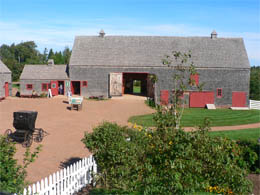
The barn |
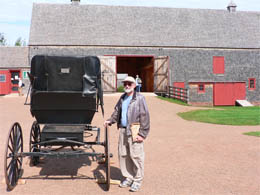
Bill by the carriage |
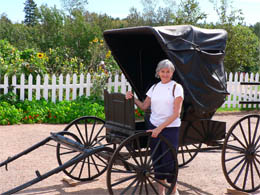
Nancy by the carriage |
Green Gables was an authentic house originally owned by elderly cousins of Lucy Maud and obviously the inspiration for Anne of Green Gables. We heard that the couple who lived in the house had adopted a little girl, further inspiration for Anne Shirley, but when I asked the Park Ranger for verification, she said, “No, the couple had two boys. Other museums fabricate stories – but we work for the government and we have to tell the truth.” Bill and I both chuckled – it doesn’t work that way in our country.
There were lots of tour groups from cruise ships (you can tell because they were all tagged with their boat number) and lots of Japanese tour groups. The Japanese love Lucy Maud and come in droves to pay tribute to her – amazing site to see them buying Lucy Maud Montgomery
books and
souvenirs!
I managed one major faux paux. I saw a couple dressed in what I thought was period costumes. The man wore a black hat, black trousers with buttons, and a white shirt (circa 1800’s). The woman wore a long skirt and white organdy bonnet. I approached the man and asked if he was grandpa. He quickly scurried away. I thought that was rude behavior for a park employee – so I asked a Park Ranger if they had people dressed in 1800’s attire as guides. She immediately started laughing and said the couple I saw was Amish visiting from Pennsylvania. She said everyone from the cruise ship was trying to get their pictures taken with the little Amish couple and it was making them crazy. How embarrassing!
We hiked on a couple of trails behind the house. The “Haunted Woods” hike was where Lucy Maud (in real life) and her created character, Anne Shirley, walked through the mysterious woods. I enjoyed the simple plaques with Lucy Maud’s description of how nature spoke to her.
The second hike, “Balsam Hollow,” begins as “Lover’s Lane,” then wanders through mixed woodlands and follows a babbling brook. Lucy Maud once said that the brook was always happy because it’s always babbling. The trail led us to the site of Lucy Maud’s grandpa’s house – where she grew up and wrote Anne of Green Gables. The house was no longer there, but the grounds are so magical. Several plaques quoting passages from Lucy Maud’s works described what she had seen there -- the garden, the old apple tree (still standing for over 150 years), views from the windows, and the pathway home when she first spotted the light in the kitchen. I was struck by such soulful insights to this beautiful setting.
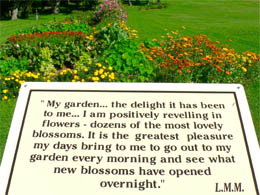
Plaque describing the garden in the background |
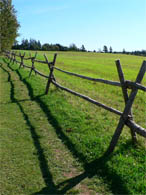
The path home |
We stopped at the bookstore and bought my friend Karen a book of Lucy Maud’s poems and then strolled through the little town of Cavendish, Lucy Maud’s old stomping grounds. We saw the Post Office (and museum), the church where Lucy was the organist (1902 – 1911) and the graveyard where she is buried. We didn’t actually see her grave. Bill wasn’t up for tracking down her tombstone.
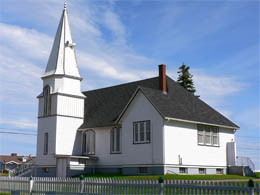
Cavendish United Church of Canada |
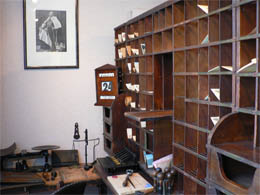
Cavendish Post Office |
After having our fill of Lucy Maud we headed to the Visitor Center in Cavendish for guidance. The folks at these places are great! Within 15 minutes we booked a place to stay in Charlottetown for the night, got a recommendation for lunch, bought a couple of t-shirts for Daan and Ko, and checked our email. We went on down the road to Chez Yvonne for a great turkey sandwich. The owners have a turkey farm.
After lunch, we headed back to PEI National Park for more hiking. We hiked the “Homestead” trail. The 3-mile trail passed though forest and farmland to the shores of New London Bay. We noticed lots of apple trees left from the early settlers. Man, those apple trees are hardy. We walked along the coast and disturbed a few Great Blue herons in their peaceful setting. We watched a field of green beans waving in the wind. Where’s our movie camera when we need it? We also saw touches of reed grass, wildflowers and bright yellow butterflies. Now I understand how the little things in nature so inspired Lucy Maud Montgomery.
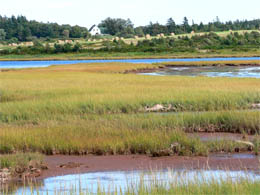
Farmland in the background |
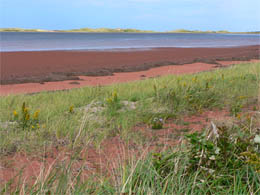
Shores of New London Bay |
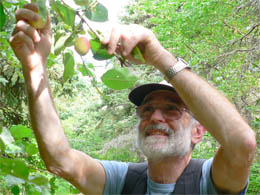
Bill picking apples |
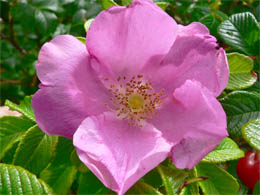
Wildflower |
We drove to the eastern section of the park (through Brackley Beach). There were lots of tacky little cabins stuck out in former cow pastures. Glad we didn’t stay in a cabin. We also drove through several fishing villages and stopped at the Covehead Lighthouse.
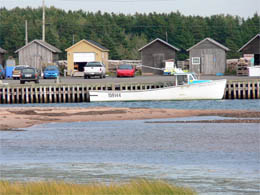
Fishing Village |
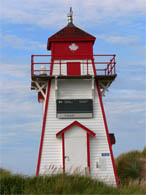
Covehead Lighthouse |
At Dunes trail, we hiked on a floating boardwalk over McNeill’s pond and then up and over the sand dunes dotted with tall grass. We also scurried over red sand rock cliffs. I loved walking back along the desolate beach.
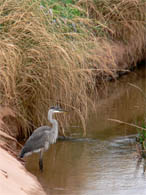
Great Blue Heron hiding |
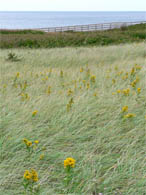
Golden rods in the tall grass |
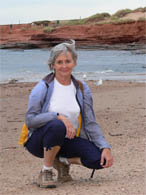
Nancy on the shore |
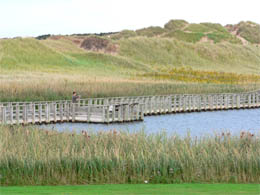
Boardwalk along MacNeill’s Pond |
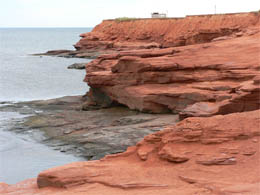
Red rock cliffs along the shore |
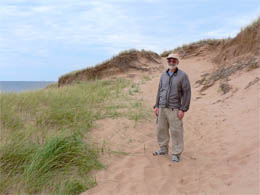
Bill hiking on the sand dunes |
Our last stop of the day was at the old hotel, Dalvay-by-the-Sea. It was originally constructed as a summer home in 1896, and now is an elegant old Victorian hotel in a beautiful setting by the sea. As I walked though the lobby and dinning room, I could almost feel the ghosts of rich shipping magnets and their mistresses moving secretly through the wood paneled hallways.
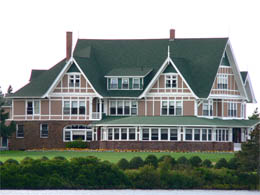
Hotel - Dalvay-by-the-Sea |
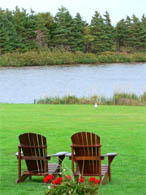
Hotel grounds |
We were losing sunlight. It was time to find our B&B for the night. We gave “The Bitch” the address and let her direct us “home.” She was great. Within 30 minutes we were at the home of Bob and Aldine Corrigan in suburbia Charlottetown. (Corrigan's B&B– 38 Braemore Ave – Charlottetown PE CIE IP8 – 902.566.3487)
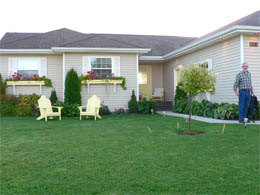
Corrigan’s B&B in suburbia |
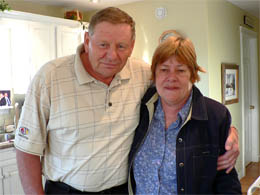
Bob and Aldine Corrigan |
The Corrigan’s home was immaculate. We felt like we were visiting relatives – only relatives that we liked! Aldine’s first comment to us was, “You two keep in shape.” (Well, a few more fish and chips and those days will be gone!) We were all about the same age. They had been married for 40 years – have one son and two daughters. Currently they have a grandson and just learned that both their daughters are expecting twin girls in the fall. Can you imagine that? Bob is a retired schoolteacher who likes to play golf. Aldine was a teacher, but now works in some employment field. We really liked them and could jabber on all evening, but we were hungry and needed fuel.
Bob showed us the map and the way to Papa Joe’s on University for some really good home cooking. He was right. Bill had lasagna and I had a Kibbi / middle eastern meat loaf and salad. Both yummy.
We drove around Charlottetown, the capital of PEI province (population 35,000). Charlottetown is named after King George’s wife, Charlotte. The downtown was semi quaint, but the outskirts were tacky. We stopped at a Wal-Mart to get a few postcards and a chocolate bar for me.
“The Bitch” caused us problems finding our way home. She didn’t know one road was blocked and she insisted we enter a freeway that had no entrance ramp. I was getting mad at her – but Bill was standing up for her. “She’s only as good as her information.” When I told him he’s never on my side, he said, “She’s the only woman I’ve ever understood. I know her algorithms. I know how she thinks.” Can’t believe this is happening to me.
We finally found our way home (the old fashioned way – with maps)! We settled in. I was writing in my journal in their comfy living room when Aldine came up in her pj’s to show where to turn off the light. Guess it’s time for “Lights out.”
9/20 - Thursday – Charlottetown (PEI)
Aldine was off to work so Bob made us a big breakfast – egg / cheese casserole, bacon, toast plus a huge bowl of fresh fruit salad. (I picked out the bananas and kiwis and quietly passed them on to Bill.) We chatted with the other house guests – Bennie and Marie from Iowa.
This was our day “to do Charlottetown.” We drove downtown to the Visitor’s Center in Founder’s Hall (6 Prince Street). It was a busy place – checked our email and got our bearings. We decided not to do the Hippo Land and Sea Tours where you ride in a bus / boat contraption that looks like a hippo. We also passed on the Sand Castle exhibit – too pricey to see a few piles of sand.
We took off walking. A couple of college kids greeted us outside St. Dunstan’s Basilica. They were working as “Ambassadors for Charlottetown.” Their job was to greet tourists and show them around. Their job was NOT to make any specific restaurant recommendations, but we were clever and got them to tell us the best and cheapest places to eat in town. We had a few laughs with them before we moved along.
Our first stop was the St. Dunstan’s Basilica, a beautiful Victorian Gothic style stone cathedral built between 1897 and 1907 to serve the Catholic Scottish settlers. It is named for St. Dunstan the great Anglo Saxon saint from Glastonbury. The current stone structure was rebuilt in 1916 after a fire and then in 1929, it was elevated to the status of a basilica. St. Dunstan's is now the spiritual center for Catholicism in PEI.
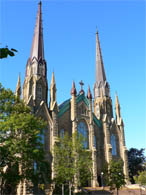
St. Dunstan's Basilica |
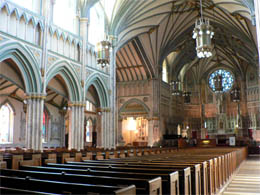
Interior - St. Dunstan's |
Our next stop was Province Hall, the birthplace of Canada’s Confederacy. In 1864, the leaders of Charlottetown hosted a conference here with leaders of the other provinces with the goal of uniting all the Canadian provinces. PEI was one of the last independent islands – other islands and areas had already united in Canada’s Confederacy. PEI, at that time, needed the support of a larger union for a couple of reasons – They needed the national railroad and they needed protection from America with its western spreading manifest destiny. (They worried that American’s domino effect would also spread northward.)
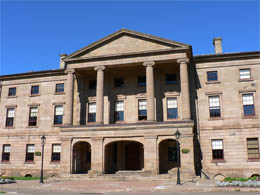
Province Hall |
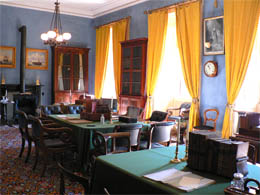
Where the delegates gathered to form Canada |
On the day the heads of Canada’s Confederacy arrived on ship, most of the PEI leaders were off to a real dog and pony circus. The head of PEI didn’t go to the circus, but instead, took a little rowboat out to greet the delegates. The delegates waiting off shore appreciated this very simple, gracious welcoming. The Confederacy convention only got better after that. The representatives decided to forget about the long informal meetings, and instead spend most of the week partying. They attended dinner parties and dances. They drank Champaign and had lots of good ole boy talk. They just got to know each other and worked out their differences over food, drink and dance. They formed their nation without signing one paper. A handshake was good enough. MacDonald, the first Prime Minister of the union was a charming drunk – but his magic worked and Canada was formed.
We walked though town and stopped at the Queen’s Mall for a little souvenir shopping -- got some magnet fish and a fish bottle cap opener. Bill was a pretty good sport. We stopped in at Brit’s (recommended by our college ambassador pals) for a great little lunch. Bill had meat pie and I went for the greasy fish and chips again – Shame on me!
After lunch, we walked to the Beaconsfield Historic House – a stately Victorian 25-room mansion, built with the latest technology for the year 1877. As part of the construction they moved a huge existing home, which was obstructing the view. Using horses, the house was moved across the street where it still stands.
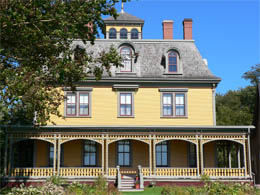
Beaconsfield Historic House |
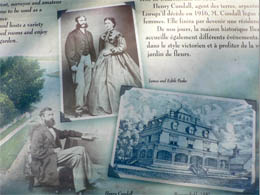
Edith and James Peake |
James Peake, Jr. (1840-1895), a wealthy merchant and ship builder, and his wife Edith spared no expense on this house. The house was a showcase. Edith was the daughter of the Lt. Governor and entertained royally at the house. Louise, daughter of Queen Victoria, came to a lavish dinner party there.
When times were good to the Peakes, they were grand, but then things turned bad, really bad. The family wealth came from the father, James Peake, Sr. The son, James Peake, Jr. lost it all in high living and staying the course producing sailing vessels when the new market was demanding steamers. He was also implicated in double bookkeeping. Their personal life was also tragic. They had six children – all died. Two of the children died of tuberculosis in the house only ten days apart.
They only lived in their elegant house for five years. The house was next occupied by a guy and his two sisters. Next, the house became a home for nurses, then it was purchased by PEI and restored. I loved the elegant rooms and wonderful wood paneling and tile floors. However, I always gravitate to the cozy kitchen and servant’s quarters – love the underdogs behind the scenes.
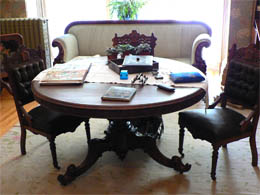
The sitting room |
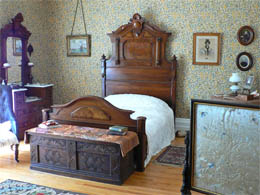
The bedroom |
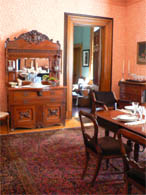
The dining room |
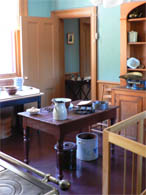 My favorite, the kitchen |
We stopped in at the PEI School of Culinary Arts to check out the evening’s menu. It looked like a great place to dine, but way too pricey for our pitiful dollar, so we walked back along the town’s wharf – not too impressive, but we’re jaded by San Diego. We stopped for an ice cream at Cow’s. It was a hot summery day, perfect for enjoying a cone and people watching. I loved the little Japanese couple sporting big ten-gallon hats.
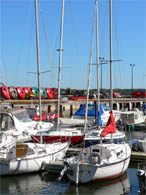
Charlottetown wharf |
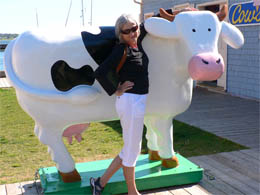
Nancy and the Ice Cream Cow |
We were getting weary of urban life, so we stopped back in at the Visitor’s Center to pick up our car. We drove to Victoria Park, right outside of town. We still weren’t far enough away from people and cars so we decided to head out of town to Rocky Pt. (only 15 miles or so southeast on 19). However, we got diverted to Port-La-Joye / Fort Amherst National Historic Site on PEI’s south shore along the Northumberland Strait. The place was closed for the season, but we took a beautiful stroll along the archeological ruins in the late afternoon sun. It was great to be in the countryside and yet we could still see Charlottetown Harbor. There were lots of markers so we could get the “jest” of the place.
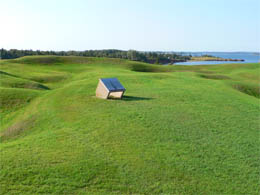
Marker on what’s left of Fort Amherst |
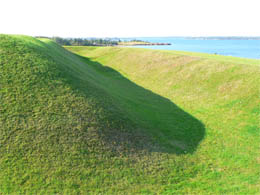
What’s left of the fort’s walls |
Port-la-Joye—Fort Amherst National Historic Site of Canada
- First permanent European settlement on Prince Edward Island settled by the French in 1720 and named Port La-Joye (French for "Port of Joy"). Port of Joy didn’t work out so well because of the very harsh winters.
- In 1720, French arrived at Port-la-Joye with 3 ships and 300 settlers – hoping for an agricultural community to supply French forts in the area. However, the colony was abandoned in 1724 due to financial failures and lack of support. The outpost was also built to protect the French farming and fishing interests on Isle St. Jean.
- Michel Haché-Gallant and his family (1720) were the first Acadian family in this French outpost. The Haché's household and those of his sons and daughters made up the core of Port-la-Joye civilian community. They and their neighbors stayed at Port-la-Joye until the autumn of 1744 when they moved inland, fearing British attack.
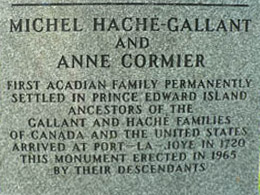
Memorial to the Haché-Gallant family |
- The Acadians and Mi'kmaq (native people) fought together against the powerful invading British.
- In 1726 Port La Joya became a French crown colony with its own commander sent from Louisbourg. A chapel, store-house, bakery, garrison, barracks and the commandant's lodgings were built.
- The outpost was destroyed by New Englanders in 1745 and rebuilt only four years later, only to fall forever to the English in 1758.
- In 1758, the British defeated Fort Louisbourg, a powerful French fort. This was a big blow to the French. The Commander at Port-la-Joye surrendered
peaceably
to Lieutenant-Colonel Rollo, commander of the British forces, waiting just offshore.
- Rollo used his soldiers to collect an estimated 3,500 inhabitants and refugees for transport to France. Of the total exiled, at least 700 drowned and many others died of sickness en route. Some families managed to escape by fleeing to safer French territories or by hiding. Thirty families of one parish escaped the deportation and the thousands of Acadians who live on the island today are descended from these families and from others who returned after the Treaty of Paris in 1764.
- Having cleared the place of French, in 1758 the British built Fort Amherst here as a temporary defensive position on the same bluff as the French outpost and settlement.
Bill and I tried to absorb some of the brutal history here. We took a lovely hike past two lighthouses, imagining all the dead bodies we were stepping over.
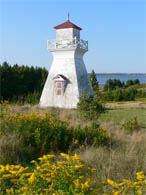
A peaceful hike |
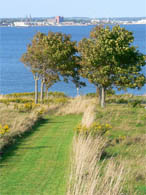
View of Charlottetown beyond the harbor
|
It was close to sundown when we returned to the car to let “The Bitch” direct us to our B&B. We arrived with no hassles, gathering our dirty clothes and then headed for a Laundromat. We got the clothes going and then went to Papa Joe’s for a beer. The place was packed – the Thursday night “Corn Beef and Cabbage Special” brought in the crowds. Bill and I sat at the bar and met Brenda. She's from Halifax, on a business trip to Charlottetown. She was lovely. She traveled a lot and gave us advice of things to see. She was sitting next to Amelia, the Lebanese matriarch of Papa Joe’s, so we got to know the woman behind this thriving business. We decided to stay for dinner. Bill got the corn beef and cabbage special and I went for the steak sandwich. At 8 o’clock, we picked up our clean clothes, went home to call it another busy, successful day on the road. |











